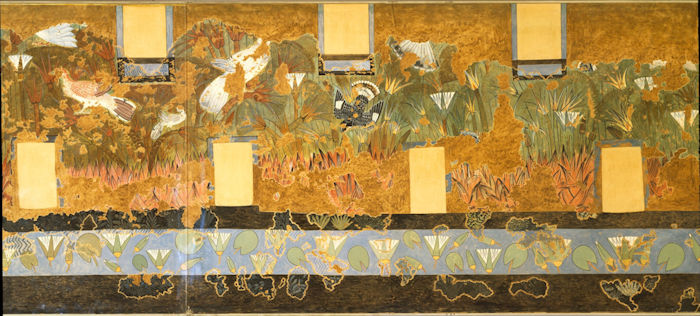Conny Waters - AncientPages.com - This magnificent artwork was discovered in a palace at Amarna, ancient Egypt's capital, during the reign of Pharaoh Akhenaten (1347–1332 B.C).
The ancient painting, hailed as a masterpiece of ancient Egyptian art, is so finely detailed that scientists have been able to identify the bird species it depicts.
Facsimile painting of the west wall from the “Green Room” in the North Palace at Amarna (Public Domain; The Metropolitan Museum of Art, New York: accession no. 30.4.134). Credit: Antiquity
In 1924 archaeologists excavated at Amarana and uncovered a palace belonging to Meritaten, daughter of the pharaoh and Nefertiti, with several lavishly decorated rooms. One of these, the so-called Green Room, has a rare depiction of birds in a wild papyrus marsh with no signs of human activity. The beautiful images of the natural world were likely to create a space for relaxation and recreation in the palace.
When the Green Room's artworks "were uncovered, the paintings were recognized as vitally important examples of “the school of Akhetaten,” where the “innovations by which the era of Akhenaten is peculiarly marked attain something like a culmination.” They have since come to be regarded as masterpieces of ancient Egyptian art. Featured in these paintings are some of the most skilfully rendered and naturalistic images of birds known from Dynastic Egypt," scientists write in their study published in Antiquity.
"Featured in these paintings are some of the most skilfully rendered and naturalistic images of birds known from Dynastic Egypt," Dr. Christopher Stimpson and Professor Barry Kemp said.
"The surviving art of the North Palace can be classified into two themes. In the North-East court, the most common theme is fowl-feeding scenes. These depict human figures feeding ducks, cranes, storks and geese against an invariably yellow ground with large red pots and dotted with red grains and scattered white or grey feathers.
(Top) detail from a reconstruction of the fowl-feeding scene from the south wall of room 7 of the North-East Court, North Palace, Amarna (B. Kemp); bottom) excerpt of the waterbank design from the west wall of the Green Room, Amarna, showing pied kingfisher (Ceryle rudis) and decorated niche (detail from N. de Garis Davies, Facsimile painting of the west wall from the “Green Room” in the North Palace at Amarna; Public Domain; The Metropolitan Museum of Art, New York: accession no. 30.4.134).
The second theme is the waterbank design remnants of which were found throughout the North Palace. In contrast to the fowl-feeding scenes, which are presided over by humans, the waterbank design depicts birds amidst thickets of riverside plants, including lotus (Nymphaea caerulea) and papyrus (Cyperus papyrus), with a stylised river at the base. The Green Room (room 12)—one of two small, interconnected rooms was so named due to the dominant colour and extent of this theme," the scientists write in their paper.
Despite the quality of the Green Room's images, they have received relatively little attention. As such, not all the bird species in the art had been identified in the nearly 100 years since it was found.
"The art of the Green Room has not received as much attention as you would perhaps expect. This may have been because the original plaster panels did not survive well," said Dr. Stimpson, an honorary associate of Oxford University Museum of Natural History. Attempts at conserving the painting in 1926 accidentally damaged and discolored the artwork.
Dr. Stimpson and Professor Kemp set out to identify the birds of the Green Room, and the result of their attempt was successful.
The researchers were ultimately able to identify several species, including shrikes and wagtails. These join the kingfishers and pigeons identified by previous work. They also found that the artists may have included hints for ancient birdwatchers: Migrant birds are annotated with a triangle, perhaps indicating a seasonal element in the art.
The artwork also may show an ancient Egyptian pigeon problem. Rock pigeons are depicted but are not native to the papyrus marshes, instead being associated with nearby desert cliffs.
Perhaps, like in modern cities, pigeons were attracted to the area by human activity.
While the researchers cannot rule this out, they think the artists instead may have included these birds to make the scene seem wilder and untamed—an atmosphere the realistic artwork appears designed to create. The team suggests these images of the natural world have made the Green Room a relaxing place.
"No one knows for sure, although the Green Room was most likely a place of rest and relaxation. Illustrations in rock tombs at Amarna possibly show similar settings where women relax, socialize and play music," said Dr. Stimpson, "In the Green Room, the atmosphere was likely enhanced by the visions of nature. The calming effects of the natural world were as important then, as they are (more than ever) today."
The study was published in the journal Antiquity
Written by Conny Waters - AncientPages.com Staff Writer








